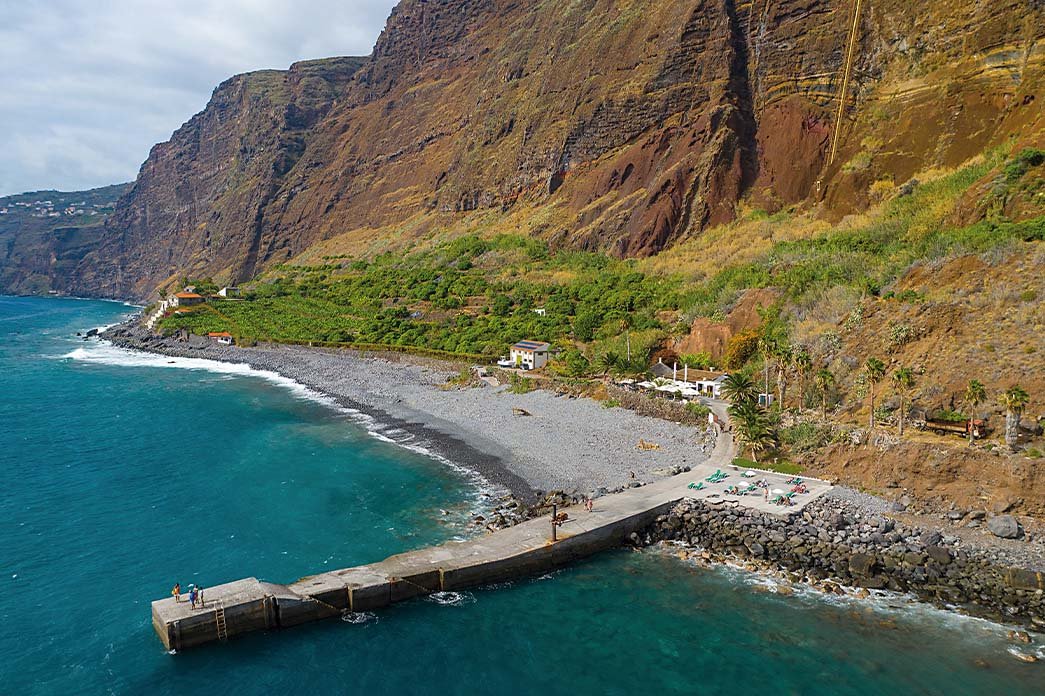
Before the journey to what many describe as a paradise, let us dissect a fundamental term: fajã. The word refers to a flat terrain, generally for farming, small in size, located by the sea, formed by materials released from the cliffs. It is exactly such a place that we are about to get to know. Fajã dos Padres is a strip of fertile land between the sea and steep cliffs, at the foot of Cabo Girão, in the parish of Campanário, a place that has a pebble beach front along its entire length. The only way to get there is by cable car or boat. But first, we still need to know why it is called ‘dos Padres’ (or ‘of the Priests’). In fact, until the expulsion of the Jesuits from Portugal, this fajã was inhabited by them. Inhabited and farmed, almost since the time when Madeira was first settled. In other words, the existence of Fajã dos Padres goes hand in hand with the history of the island itself, ever since the 15th Century, which can be proven by the numerous records and references of the owners to the agricultural crops produced there and also to its inhabitants, who numbered about 50, mostly belonging to the Society of Jesus, distributed in ten houses. But it seems that, besides the farming of the land, Fajã dos Padres also served as a place to spend the summer for the religious. Today, whoever visits this little paradise quickly understands why. The marks left by the Jesuits on this isolated piece of land are many. One of them stands out: it was thanks to this religious order that Malvasia wine was introduced to the island, whose reputation went beyond the borders of Portugal and reached England, the United States and even Russia.
It was thanks to this religious order that Malvasia wine was introduced to the island, whose reputation went beyond the borders of Portugal.
As we have just said, Fajã dos Padres is only accessible by boat or by cable car, which scales and descends almost the 250-metres cliff every day.
As this rocky outcrop constitutes an enormous barrier to the north, the fajã opens to the south with peculiar morphological characteristics that make its climate different from the surrounding regions. As it is an agricultural property par excellence, it allows the growth of exotic crops. The clarity of the waters and the variety of species along the coast also invite you to go diving and fishing. Besides this, you can also relive today some of the heritage of the Fajã’s past, which has been under the private management of a family since 1921, by visiting and staying overnight in the small restored houses, tasting the Malvasia wine on a visit to the old winery, or walking the old stone paths between the organic farming fields.
It was thanks to this religious order that Malvasia wine was introduced to the island, whose reputation went beyond the borders of Portugal.
As we have just said, Fajã dos Padres is only accessible by boat or by cable car, which scales and descends almost the 250-metres cliff every day.
As this rocky outcrop constitutes an enormous barrier to the north, the fajã opens to the south with peculiar morphological characteristics that make its climate different from the surrounding regions. As it is an agricultural property par excellence, it allows the growth of exotic crops. The clarity of the waters and the variety of species along the coast also invite you to go diving and fishing. Besides this, you can also relive today some of the heritage of the Fajã’s past, which has been under the private management of a family since 1921, by visiting and staying overnight in the small restored houses, tasting the Malvasia wine on a visit to the old winery, or walking the old stone paths between the organic farming fields.












